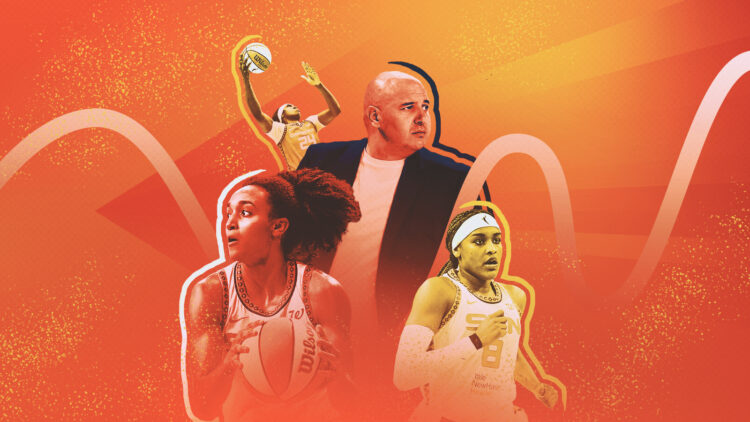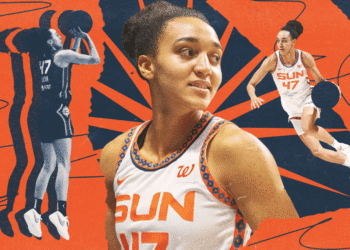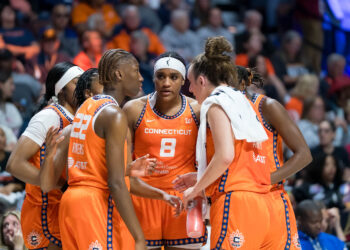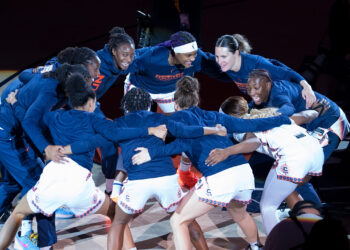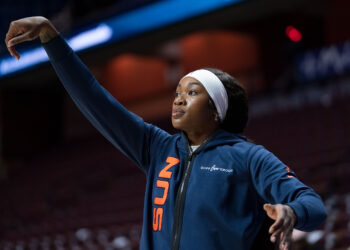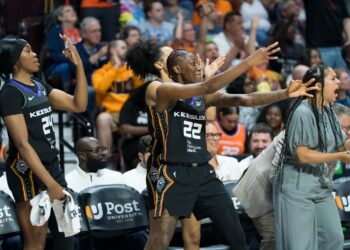After years of maintaining success despite subtle shifts in the composition of their roster, the Sun were finally forced to hit the reset button after Alyssa Thomas and DeWanna Bonner decided to pursue new paths towards a championship last winter–with several other key faces of the franchise’s extended period of success following them out the door. The change, no doubt, was abrasive for everyone in the organization, but the lasting impression of the season that followed seems to be one of hope for the future.
Season In Review
If you (understandably) lost touch with the Sun after their 2-15 start, you might have missed two key takeaways from their 2025 campaign. First, the debut of 2024 first-round pick Leïla Lacan in game 18, which—looking back—marked a turning point for the team. And second, the relatively strong finish to the season, as the Sun went 9-17 after Lacan’s debut and posted a respectable 6-8 mark in August when their core players were healthy.
Don’t get it twisted, the Sun ultimately were not a good team in 2025 as evidenced by their eleventh-placed finish in the standings, which left them 12 games adrift of the playoff cutline. For a fanbase that’s become so accustomed to winning (eight straight playoff trips before this year), no amount of moral victories or months near .500 can substitute for actual success. That being said, it was always reasonable to limit expectations after last offseason, and the completely overhauled roster,irrespective of wins and losses,took a number of observable and beneficial steps towards returning to the playoffs in the near future.
Most importantly, the Sun—ahead of an offseason of huge uncertainty across the W—maintain control of nearly all of their key players (save for veterans Marina Mabrey and Tina Charles) heading into the 2026 campaign and can expect well above average continuity next season as a result. Let’s dive into the facets of this year’s surges they’ll look to build upon, the key areas that still need review to continue rising, and the long-term outlook for one of the league’s standout franchises of the last decade.
Biggest Takeaways from 2025
The Sun has a serious core.
Entering the season, the Sun had plenty of interesting prospects but lacked a single player that could be counted on as a stalwart of the organization’s new era. Olivia Nelson-Ododa, the lone returnee under 25 years old, was a valuable player in the final years of the Sun’s almost dynasty but was hardly proven in a larger role. Second-year player Jacy Sheldon was an intriguing option but always projected as a complementary piece in the W. Aneesah Morrow and Saniya Rivers were exciting draft picks but both brought various questions about their game translating to the league. Meanwhile, Lacan, for all her overseas accolades, was no promise to even play, much less succeed, in the W this season.
Fast forward four months, and there’s reasonable evidence that four of those names will be in the rotation for the next Sun playoff team. The only outlier is Sheldon who was traded midseason for Aaliyah Edwards, who then underlined her own potential in 15 promising games to end the season. For this core to win, there’s still lots of individual improvement to make and group cohesion to build. That said, the Sun front office has every reason to believe that their work has yielded five different players who are capable of contributing to a WNBA rotation and (crucially) are under contract with the team for at least the next two seasons (Nelson-Ododa is the lone outlier as a restricted free agent).
Leila Lacan is ready for the spotlight.
Not to step on the next section, but the biggest question for this Sun core is whether any of these five likely rotational cornerstones can be more than a high-end support player. Indeed, the Sun wouldn’t be the first team to assemble the perfect supporting cast only to lack a leading star. Free agency and the draft could provide that player, but Lacan’s transformative effect on the second-half suggests the team’s 1A may already be in place.
Of course, no matter how many championships defense wins, a true 1A still needs to score consistently, something that remains a work in progress for Lacan (48/22/86 splits). Even then, she isn’t far off—scoring at a 58.9 percent clip inside the arc and 70.6 percent at the rim. Connecticut of all places knows that a non-conventional star who scores efficiently, creates dynamically, and defends at an All-WNBA level can carry a team. Lacan, though physically different, could emerge as Alyssa Thomas’ spiritual successor in the Northeast.
Any offensive growth—especially the addition of a semi-reliable three-point shot—should eliminate doubt about her potential as a number-one option. Projection and reality often differ, but her 2025 on-court performance was already ahead of schedule, with her defense already placing her amongst the league’s best.
Rachid Meziane is capable of leading a franchise.
Critical emphasis on the word leading here because, while there were plenty of impressive tactical elements to Meziane’s first season as a WNBA head coach, there were also some areas where the Sun fell short and, frankly, they didn’t play many truly meaningful games beyond the first few weeks of the season.
Caveats aside, the spirit that Meziane generated even amidst the most dreary of circumstances, for me, speaks to his capacity as a leader. After an incredibly tough seven weeks to start the season, it would’ve been very easy for the Sun to pack it in,especially as some questioned whether Meziane should’ve been hired in the first place.
Instead, the Sun continued rowing in the same direction and, when the stars aligned in August, they were amongst the league’s most competitive teams,even if they sometimes lacked the precision necessary to close out games. Crucially, they didn’t just win because of red-hot offensive outings that come-and-go. Rather, the Sun’s wins typically came by virtue of playing disciplined, team-oriented offense while maintaining a ferocious defensive level of energy.
Bigger expectations will follow in the years ahead, and Meziane will be asked to validate his coaching credentials under more pressure, but there’s every reason to believe that he’s capable of navigating the inescapable human highs and lows of his profession based on this season.
Biggest Questions for 2026
How do you fill out this roster? (and does it matter?)
In terms of constructing the Sun roster for the 2026 season, I see a surprising number of parallels with the scenario the Chicago Sky faced last winter. After year one of a near complete rebuild, they seem to be ahead of schedule, and there’ll be definite chances (especially with this large free agent class) to accelerate their timeline–but always with an opportunity cost attached. However, the opportunity cost of a free agent signing is always lower (especially on a one-year deal), and you’d have to think there’s a few players around the W who might be intrigued by what Connecticut has to offer.
In essence, if the Sun wanted to skip ahead towards winning, they’d be after a player like 2024 Kelsey Plum: a secondary or tertiary option with number one potential and, crucially, number one ambition. With the young core all under rookie contracts for at least two more years (again, ONO excluded), there’s room to give two years of that money away and still retain your core when it’s time to do so. Of course, whether free agents are actually looking to come to Connecticut (for a variety of mostly off-court reasons) is an entirely different story (again, parallels to Chicago). If they are, the only real question that GM Morgan Tuck should be concerned with is whether a high-profile arrival would stunt the development of her young core.
And if high profile arrivals aren’t on the cards for this offseason, that should honestly be of little concern. Instead, the main focus of building the 2026 roster (besides resigning Nelson-Ododa) should be trifold: seeking out young players on the cheap (like Edwards), adding variety to see which profiles work alongside the core, and preserving future financial flexibility while other teams inevitably get greedy.
What does the frontcourt rotation look like?
For all the praise I’ve given the Sun’s core of five young players, the long-term role and fit is a lot clearer for Lacan and Rivers than for the trio of frontcourt players. Perhaps more importantly, there’s still questions about all three of those players’ games.
Morrow is the only of the three that adds positively to the spacing but still shot only 24 percent on 1.8 threes per game as a rookie. Nelson-Ododa is clearly the team’s best interior defender but is less developed offensively. And Edwards, ironically, was traded from a situation with too many bigs in Washington to…a situation with too many bigs in Connecticut. There was evidence to suggest that you can build a competent frontcourt rotation out of these three—all are at least capable at both ends which helps—but there’s a delta between competence and excellence.
Tuck and Meziane will have to think carefully about how long they can afford to work on closing that delta before being forced to make the same decision Washington did in trading Edwards. For now, this is a minimal concern for 2026–especially if Charles departs–but this could be an enormous talking point (with a looming decision) in a year’s time.
Does off-court business impact on-court focus and progress?
Unless you’ve lived through a franchise flirting with relocation, this is an impossible question to answer, but you’d have to think there’s some kind of knock on effect from the off-court noise around a potential change in ownership and/or move to Boston. Granted, a move two hours north isn’t so drastic that players should be super preoccupied about uprooting their lives and families, but stability is always preferable when you’re committing to a multi-year contract.
Perhaps more importantly, everyone knows that new owners love to make changes that ensure their vision for the organization is shared by those in power, meaning Tuck and Meziane are always likely to be watching their backs should such a change happen. That’s not to say that any fire comes from all the smoke around the Sun, but it would also be somewhat surprising to see the status quo maintained after everything that made it all the way to the press this year.
Long-Term Forecast
If you’ll forgive a quick pun, things are looking quite sunny for Connecticut after the cloudiest of offseasons saw fan favorites and franchise cornerstones depart en masse. A rookie coach and GM delivered positive progress (despite a negative record), and that sets a very strong foundation for the franchise in the years ahead. Crucially, the public messaging from Meziane and Tuck this season has been incredibly consistent.with both pointing towards the team’s desire to, first and foremost, develop a culture.
Personnel wise, you’d have to think the Sun will swing big for at least one name,with their current roster construction meaning that’s likely to come in the backcourt. No one knows what will come of the ownership situation, but any new owner could make a huge splash (à la Mat Ishbia) by purchasing the team before free agency opens and instantly backing Tuck’s pitch to free agents with a huge commitment to off-court investment. Indeed, the opportunity here—whether in Connecticut or Boston—seems too good to pass up for a keen investor, and the most plausible outcome, like in Phoenix, is that the fortunes of the organization will profit as a result. Regardless, the wealth of on-court talent means that a return to the playoffs within the next couple of seasons feels more than plausible regardless of who’s signing the checks.
All stats as of the 2025 season. Unless otherwise noted, all stats courtesy of Basketball Reference.
